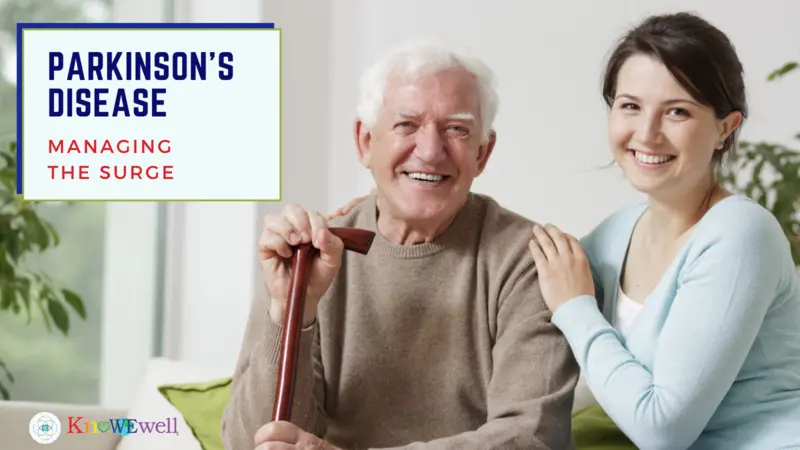

Chronic Conditions and Diseases

Chronic Conditions and Diseases
Managing the Surge in Parkinson’s Disease
Once considered a rare disorder, Parkinson’s is on the rise in the modern era
First described as a condition in 1817 by Dr. James Parkinson, Parkinson’s disease was considered a rare disorder for most of its history. However, the modern era has seen an explosion in rates and it is now the world’s fastest-growing neurological disorder.
A study by the Global Burden of Disease, which measures epidemiological trends around the world, estimates the number of people with Parkinson’s increased in every region of the world between 1990 and 2016—a global increase of 118%. An estimated one million Americans are currently living with the disease, and experts believe this number will double over the next 25 years. The incidence of the disorder increases with age and rises sharply at around age 65. However, many younger adults develop the disease and the prevalence rate among adults between ages 30 and 64 has increased 50% over the past five years. The lifetime risk of developing the condition is now 1 in 15.
Parkinson’s is a long-term neurodegenerative disorder characterized by a progressive decline of motor functions and may include symptoms such as tremors, rigidity, and problems with stability and balance. This occurs when brain cells stop making dopamine, a molecule involved in movement. Nonmotor symptoms may occur, such as memory problems, depression, loss of smell, constipation, and sleep disorders, but these vary widely from person to person, as does the progression of the disease.
An estimated one million Americans are currently living with the disease and experts believe this number will double over the next 25 years.
There are currently no tests available to diagnose Parkinson’s. Doctors make a clinical diagnosis based on a physical exam and medical history. A top priority of the Michael J. Fox Foundation is funding research to find biomarkers that can be used to develop an objective test for earlier diagnosis.
What Causes Parkinson’s?
Scientists believe that Parkinson’s is caused by a combination of genetic and environmental factors. A 2018 paper published in the Journal of Parkinson’s Disease attributes the growing rates of the disease to an aging population and the environmental by-products of industrialization. Increased life expectancy rates, the authors say, will result in a 12% increase in prevalence rates over the next two decades.
Countries that have seen the greatest increase in rates of Parkinson’s are also those that have undergone the most rapid industrialization. Between 1990 and 2016, the rates of the disorder in China more than doubled, the largest increase of any country.
Exposure to common neurotoxic chemicals, such as trichloroethylene (TCE), a chemical used in dry cleaning and household products, has been linked to an increased risk of developing Parkinson’s. A 2011 study found workplace exposure to TCE increased the risk of developing the disorder sixfold. The Environmental Working Group estimates TCE is present in about 30% of US groundwater. To date, only two states—Minnesota and New York—have banned the use of TCE. Certain pesticides, including the weed-killer, paraquat, whose use is on the rise in the US, are also implicated in the rise in Parkinson’s incidence.
While most Parkinson’s research has focused on the brain, specifically on the loss of dopamine-producing neurons, a growing body of research suggests the disease may originate in the gut and travel to the brain through the vagus nerve. Researchers have found clumps of the protein alpha-synuclein in both the brain and the gastrointestinal nervous system in Parkinson’s patients. When researchers injected these proteins into the gastrointestinal tracts of mice, the proteins traveled through the vagus to the brain. In studies where the vagus nerve is severed, patients have a lower risk of developing Parkinson’s.
Another study suggests that intestinal inflammation may be a contributing cause of Parkinson’s. Researchers at the Icahn School of Medicine at Mount Sinai analyzed data from over 200,000 patients in two large US medical databases, looking at overlap between inflammatory bowel disease (IBD) and Parkinson’s. Among those with IBD, the prevalence of Parkinson’s was 28% higher than those in the control group. The researchers also found that the people who received drugs to reduce inflammation had a 78% lower incidence of developing Parkinson’s.
Treatments for Parkinson’s
Treatment of the disorder is frequently focused on replacing and maintaining dopamine in the brain through pharmacological drugs. The most effective drug for the disease, levodopa, was developed more than 50 years ago. Clinical trials are underway for newer treatments, including immunotherapies that use monoclonal antibodies and regenerative treatments that use cell-based and gene therapies. Trials are underway to examine repurposing existing drugs for use in Parkinson’s patients, such as a class of drug that reduces alpha-synuclein pathology. Researchers are studying new non-invasive techniques for deep brain stimulation (DBS) which would deliver the benefits without the risks of surgery.
A growing body of research suggests the disease may originate in the gut and travel to the brain through the vagus nerve.
While these new developments show promise, conventional therapies offer only partial and temporary relief for patients. In a paper published in the Journal of Parkinson’s Disease, researchers from the University of North Carolina (UNC) advocate for an interdisciplinary approach—patient-centered care managed by a team of healthcare professionals. Patients are more likely to comply with recommendations when they are more directly involved in their treatment.
The interdisciplinary team would likely include a range of disciplines, including physical, speech, and occupational therapists; nurse practitioners; social workers; and psychiatrists. This team approach is tailored to patient preferences, needs, and expectations and allows for a more fluid treatment plan than a traditional referral-based model.
Studies of the interdisciplinary model of care show promise. One trial compared the outcomes of Parkinson’s patients that received an eight-week multidisciplinary treatment plan with those who were waiting to receive the same treatment. The intervention group scored significant improvements in bodily discomfort and other motor experiences of daily living compared to the control group.
Another study treated 118 patients and their caregivers for six weeks with a program that included education sessions and individual care from a team that included a Parkinson’s neurologist, nurse, physical and occupational therapists, dietician, and psychologist. At the end of the intervention period, participants showed significant improvements on the timed walk test, gait, voice articulation, depression scores, and quality of life measures.
Another growing trend in treatment of Parkinson’s is the integrative medicine approach, which combines practices from both traditional and nontraditional medicine. In addition to conventional pharmaceutical therapies, the integrative approach also makes use of complementary and alternative medicine (CAM), which includes use of natural botanical compounds and over-the-counter (OTC) substances, and mind-body practices to treat symptoms.
In a 2020 paper published in Topics in Geriatric Rehabilitation, researchers from the UNC School of Medicine identified herbal or OTC compounds that may be used to treat Parkinson’s, based on a number of criteria. These include:
- Taurine – an essential nutrient from animal and fish proteins that has been shown to protect dopaminergic neurons.
- Trans-Resveratrol – an antioxidant that has been shown to reduce oxidative stress and improve behavior patterns in a mouse model of Parkinson’s.
- N-Acetyl-cysteine (NAC) – a building block for glutathione, an antioxidant that helps reduce oxidative stress. NAC has been shown to increase dopamine transporter binding and slow disease progression.
- Vitamin D3 – a fat-soluble vitamin that has been shown to improve cognitive impairment in Parkinson’s patients.
- Vitamin B1 – Deficiency of B1 in Parkinson’s patients is linked to cognitive decline. B1 may have a neuroprotective role. Patients should start with a minimal amount and gradually increase dose over several weeks or months.
- Magnesium – a neuroprotective essential nutrient that helps regulate muscle and nerve function and has been shown to block dopaminergic neuron loss in a mouse model of Parkinson’s.
- Curcumin – a spice with strong antioxidant and anti-inflammatory actions that has been shown to be neuroprotective in rodent models of Parkinson’s.
- Alpha Lipoic Acid (ALA) – found in broccoli, spinach, tomatoes, and peas, ALA has been shown to improve memory in older rodents. ALA is not recommended for patients with hypothyroidism.
- Acetyl-L-carnitine (ALC) – studies suggest ALC is beneficial for the brain and has been shown to improve memory in older rodents and may be neuroprotective in the progression of Parkinson’s.
- Vitamin C – an antioxidant that may reduce damaging oxidative stress.
- Probiotic complex – Research has shown probiotics lowered inflammation markers and Parkinson’s motor symptoms after 12 weeks of supplementation.
- Ashwagandha – an anti-inflammatory herb commonly used in Ayurvedic medicine, shown in studies to reduce stress and improve quality of life.
The integrative medicine approach to Parkinson’s treatment also includes use of mind-body therapies. Although the research is preliminary for most of these therapies, they are considered safe and have shown benefits.
Another growing trend in treatment of Parkinson’s is the integrative medicine approach.
Tai Chi and Qigong have both shown promise for improving nonmotor symptoms like depression, memory loss, and pain. A 2017 systematic review of 11 studies of 548 Parkinson’s patients found the participants who practiced Tai Chi had better balance and elevated well-being. Other studies have shown Tai Chi improves motor function, balance, and functional mobility among those with Parkinson’s.
Several recent reviews have also found acupuncture to be beneficial. One meta-analysis of 27 studies found that the patients who used acupuncture in combination with pharmaceutical treatment had markedly improved symptoms compared to patients who used only pharmaceutical treatment.
Massage therapy has been shown to reduce Parkinson’s symptoms and improve quality of life. One randomized controlled pilot study found participants had significantly reduced salivary cortisol, a biomarker for stress, immediately after a massage treatment. In addition to relaxation, massage may relieve muscular stiffness and rigidity, help with anxiety and depression, and improve sleep.
Both music therapy and nature-based therapy are known to improve cognitive and emotional symptoms of Parkinson’s. In particular, rhythmic auditory stimulation, in which a steady beat from a metronome sets the pace for movement such as walking, can help with freezing or step coordination. Rhythmic-based therapies that include singing and drumming can improve gait and motor function and help some people with speech issues. Nature therapy has been shown to reduce stress, improve mood, and help with pain management, so more Parkinson’s treatment centers are investing in outdoor therapy areas with benches, gardens, and birdfeeders.
Some experts advise spending a little time each day practicing mindful meditation. Studies have shown that mindfulness practice can improve cognition and motor function, as well as reduce stress, anxiety, and depression in Parkinson’s patients. Use of aromatherapy, or essential oils, may offer additional therapeutic benefits.
Other Lifestyle Interventions
Exercise and movement are especially important for people who live with Parkinson’s. The Parkinson’s Outcomes Project, the largest clinical study of people with the disorder, has found that 2.5 hours of exercise per week can improve quality of life and mobility. Other studies have shown that exercise slows progression of the disease and reduces severity of symptoms. A comprehensive review found people with Parkinson’s experience the greatest benefits from an exercise routine that includes aerobic exercise such as stationary cycling, strength training such as weightlifting, and exercises that focus on balance/flexibility such as stretches.
Finding exercise that provides enjoyment will help patients adhere to a regular routine. One study found a combination of stretching and upper-body karate moves improved gait, tremor, and grip strength. Dance, such as the Argentine tango, has been shown to improve motor function, balance, and executive function. Dancing with a partner helps with safety and balance and helps build connections with others. Yoga, too, can improve balance, mobility, and strength, and there’s evidence that it eases depression and anxiety. Boxing exercises have been effective in improving gait, posture, hand-eye coordination, and balance.
The Parkinson’s Outcomes Project has found that 2.5 hours of exercise a week can improve quality of life and mobility.
A growing body of research suggests diet can be a powerful tool in managing Parkinson’s. Scientists from Oxford University authored a paper, recently published in Frontiers in Nutrition, describing how a chemical in the body, beta-hydroxybutyrate, acts as a signaling molecule in the brain involved in mitochondrial function that helps limit the effects of oxidative stress and inflammation and is a resource in the production of dopamine. Because people with Parkinson’s have higher levels of oxidative stress and inflammation, and impaired dopamine production in the brain, researchers believe this molecule may target the underlying mechanisms at the core of the disease. As beta-hydroxybutyrate is produced when the body is in a state of ketosis, experts recommend dietary strategies like calorie restriction or a ketogenic diet.
A 2018 study published in Movement Disorders compared the benefits of following a ketogenic diet and a low-fat diet in patients with Parkinson’s. Conducted over an eight-week period, the study found that both diets improved motor and nonmotor symptoms, but the ketogenic diet, high in fat and low in carbohydrates, showed more improvement in pain, fatigue, and cognitive impairment.
The functional medicine approach to managing Parkinson’s also emphasizes the importance of diet. Personalized treatment plans are based on symptoms and disease progression. Guided by recent neurodegenerative disease research, these may include nutrients such as omega-3 fatty acids and vitamin D and the Mediterranean and ketogenic diets, which have been shown to slow disease progression and improve quality of life for patients.
The functional medicine approach to managing Parkinson’s emphasizes the importance of diet.
In general, a healthy diet will include whole foods such as colorful fruits and vegetables that are rich in antioxidants, lean animal protein eaten in small portions throughout the day, and healthy fats. Eating high-fiber foods and drinking enough water can ease symptoms of constipation common among Parkinson’s patients.
Sleep is critically important for those with Parkinson’s, yet up to 90% of patients experience sleep disturbances. Experts recommend establishing a routine to help relax and prepare for sleep that may include a hot bath, reading, or a mindfulness meditation. Other tips for good sleep include turning off electronics a few hours before bedtime and sleeping in a dark, cool room.
As more and more people are receiving the diagnosis of Parkinson’s, breakthroughs in research are all the more urgent. Many people living with the disease have found that participating in research studies can be an empowering way to help others and assist the scientific community. The Michael J. Fox Foundation offers a trial finder tool for people interested in volunteering to participate in groundbreaking Parkinson’s research.
REFERENCES
Blue Cross Blue Shield. (2020, October 22). Prevalence of Parkinson's disease rising in younger adults. https://www.bcbs.com/the-health-of-america/reports/prevalence-of-parkinsons-disease-rising-younger-…
David Perlmutter MD. (2020, October 13). How a Keto program helps Parkinson’s disease. https://www.drperlmutter.com/how-a-keto-program-helps-parkinsons-disease/
Dorsey, E. R., Sherer, T., Okun, M. S., & Bloem, B. R. (2018). The emerging evidence of the Parkinson pandemic. Journal of Parkinson's Disease, 8(s1), S3–S8. https://doi.org/10.3233/JPD-181474
Hall, M-F.E., & Church, F.C. (2020). Integrative medicine and health therapy for Parkinson disease. Topics in Geriatric Rehabilitation, 36(3): 176-186. https://journals.lww.com/topicsingeriatricrehabilitation/Fulltext/2020/07000/Integrative_Medicine_a…
The Institute for Functional Medicine. (n.d.). Neurodegenerative disease: Improving outcomes through nutrition. https://www.ifm.org/news-insights/neuro-slowing-neurodegeneration-with-nutrition/
Kwon, D. (2018, May 8). Does Parkinson’s begin in the gut? Scientific American. https://www.scientificamerican.com/article/does-parkinsons-begin-in-the-gut/
Matei, A. (2021, April 4). Rates of Parkinson’s disease are exploding. A common chemical may be to blame. The Guardian. https://www.theguardian.com/commentisfree/2021/apr/07/rates-of-parkinsons-disease-are-exploding-a-c…?
Michael J. Fox Foundation. (n.d.). Parkinson’s 101. https://www.michaeljfox.org/
National Center for Complementary and Integrative Health. (2018, May). Parkinson’s disease and complementary health approaches: What the science says. US Department of Health and Human Services, National Institutes of Health. https://www.nccih.nih.gov/health/providers/digest/parkinsons-disease-and-complementary-health-appro…
Parkinson’s Foundation. (n.d.) Understanding Parkinson’s: Statistics. https://www.parkinson.org/Understanding-Parkinsons/Statistics
Phillips, M. C., Murtagh, D. K., Gilbertson, L. J., Asztely, F. J., & Lynch, C. D. (2018), Low‐fat versus ketogenic diet in Parkinson's disease: A pilot randomized controlled trial. Movement Disorders, 33(8), 1306-1314. https://doi.org/10.1002/mds.27390
Prizer, L. P., & Browner, N. (2012). The integrative care of Parkinson's disease: A systematic review. Journal of Parkinson's Disease, 2(2), 79–86. https://doi.org/10.3233/JPD-2012-12075
Stoker, T. B., & Barker, R. A. (2020, July 31). Recent developments in the treatment of Parkinson's Disease [version 1; peer review: 2 approved]. F1000Research 2020, 9(Faculty Rev):862. https://doi.org/10.12688/f1000research.25634.1
University of Minnesota. (n.d.). What are some integrative therapies to consider for Parkinson’s? https://www.takingcharge.csh.umn.edu/what-are-some-integrative-therapies-consider-parkinsons
University of Minnesota. (n.d.) What lifestyle changes are recommended for Parkinson’s disease? https://www.takingcharge.csh.umn.edu/what-lifestyle-changes-are-recommended-parkinsons-disease


 By
By







